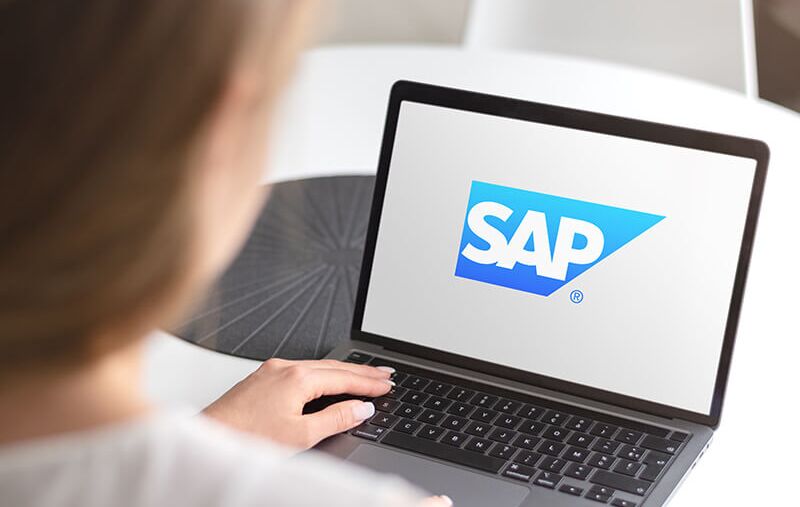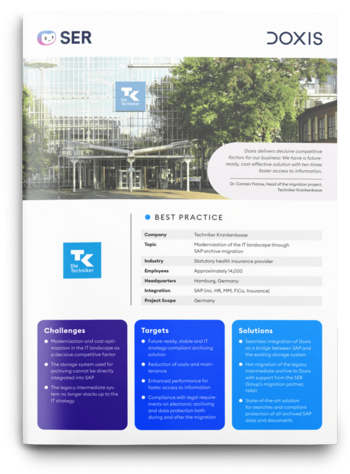SER Blog Customer Stories & Use Cases
SAP archiving: Audit-proof document storage
According to regulatory requirements on electronic recordkeeping, companies must retain business-related digital documents for a set period in an auditable format. This can be challenging because SAP doesn't provide an audit-proof archive. Yet the volume of data and documents that businesses have to manage is increasing constantly, which results in more administrative work.
In this article, we share with you how you can efficiently implement audit-proof storage in SAP with the help of interfaces to third-party systems.

Data archiving vs. document archiving: What are the differences?
SAP differentiates between data archiving and document archiving.
Data archiving
Data archiving describes the long-term retention and storage of data that is no longer actively used. Businesses are required to archive such data as early as possible in an audit-proof manner in suitable systems.
You can still access the data, if necessary, although editing functions are limited. As an archive object, the data can no longer be modified.
Document archiving
Certain business-related documents, such as contracts, invoices, and financial reports, must be stored securely for a legally mandated retention period. The requirements for digital archives vary by jurisdiction but typically ensure that records remain tamper-proof, traceable, and accessible for audits.
What is audit-proof archiving?
In general, audit-proof archiving means storing data and documents in a findable and traceable form. For example, they have to be protected against later modification, falsification, or manipulation. You cannot edit files once archived.
The criteria for ensuring archive objects are audit-proof are defined by regulatory standards such as ISO 14641 (electronic document management), SEC Rule 17a-4 (financial records retention in the U.S.), GDPR (data protection in the EU), and various national tax and compliance regulations. Storage systems can help you to store archive objects properly and completely. A version history provides a record of any changes made to documents. This means that all business activities are traceable, and it is the only way to ensure that the files can be audited – at any time. Audit-proof archiving protects data and documents from loss.
The problem with archiving in SAP
In SAP, you save data and documents on a content server, i.e. a separate service. Simply storing documents is not the same as archiving. Proper archiving systems take into account legal requirements and fulfill basic principles of digital archiving.
For your business this means: simple storage systems such as SAP's Content Server are not audit-proof and do not meet minimum legal requirements. For legally-compliant archiving, you need third-party systems that are connected to SAP via an interface; these systems can provide you with an audit-proof archive for your documents.
Audit-proof archiving with a third-party system
Third-party archiving systems such as a certified document management system (DMS) or an enterprise content management (ECM) system can help you to store information in an audit-proof manner. Ideally, the software provides a standard interface to SAP. This ensures the flow of information in both directions.
How does this work in practical terms?
- Work in SAP as usual and, for example, create a new supplier*.
- This triggers an event in the DMS and automatically creates a suitable supplier file.
- Every document and file that is relevant to the supplier is now stored in the supplier file.
- You can use the interface to access the documents and files in the DMS or ECM system directly in SAP.

Customer Story: Modernization of the IT landscape through SAP archive migration
Read all about how Techniker Krankenkasse (TK) launched a stable, future-ready archive solution with Doxis, achieving 10x faster access to documents.
Read nowAudit-proof archiving in a DMS or ECM?
Document management system
A document management system manages all of your business's documents in a central location – from the day a document is created until it is deleted from the system. This also includes the audit-proof archiving of documents such as invoices, contracts, applicant data, or transaction records.
Additionally, a DMS manages all the information in a GDPR-compliant manner. Audit security includes the processing of sensitive and personal data in accordance with relevant laws and regulations.
Enterprise content management system
An enterprise content management system can, on the other hand, do much more. The heart of an ECM system is usually the DMS, which is supplemented by a range of software applications that set up and largely automate entire business processes. An interface to SAP expands the system to include ECM functionalities.
For example, OCR text recognition and automated data extraction in the DMS are used to capture and structure information from a scanned document. The ECM then transfers this information to SAP. If you integrate other third-party systems in addition to SAP, such as Microsoft Office, Salesforce, or SAP SuccessFactors, you can create smooth workflows across multiple systems.
Use Case: SAP SuccessFactors archiving solution with ECM system
Based on the example of SuccessFactors, we will show you how an ECM system can make data archiving in SAP audit-proof. SAP SuccessFactors describes itself as a human experience management suite, which includes solutions for the HR area from recruiting to learning management.
ECM system in combination with SAP SuccessFactors
Hey Doxi, how does data archiving with an ECM system work in combination with SAP SuccessFactors?
An interface connects the ECM system with SAP SuccessFactors. When an application is received, not only is a new applicant created in SAP SuccessFactors, but a new record is also created in the ECM. All documents are automatically transferred and made available to authorized users. Here you will find all of the applicant's documents – from CV to cover letter.
The application workflow then begins and an employee can review the application. This user will find the link to the digital applicant file on the applicant screen, and will be able to access the documents in Doxis directly from SAP SuccessFactors.

Doxis Intelligent Purchase-to-Pay Automation
The AI-powered solution suite Doxis Intelligent Purchase-to-Pay Automation automates content and processes to improve information visibility, reduce risk and ensure higher profitability.
Read nowBenefits of archiving documents and data from SAP in an ECM system
There are four main benefits of combining an ECM system with SAP:
- Compliance: Files and data are archived in an audit-proof manner, which is not possible in SAP alone.
- Single source of truth: All documents are stored in one software.
- Efficient technologies: By using state-of-the-art technologies in ECM, such as OCR, AI and machine learning, you can automate business processes and make them more efficient.
- Avoid media disruptions: ECM systems seamlessly integrate audit-proof archiving in SAP without complicated software jumps.
SAP and the ECM system exchange information with each other. Communication between the systems and the user is also seamless. This means that you continue to implement all work steps in SAP. The ECM system works in the background. You don't have to leave SAP to archive or view documents.
Additional benefits arise from the technologies provided by an ECM system. For example, OCR technology combined with AI comprises one part of an ECM system. The resulting efficiency gains in the application save time and resources. This way you can design your next archiving project even faster and more automatically – directly in the SAP system, of course.
Summary: Make data archiving with SAP audit-proof
In summary, archive files in SAP do not, by default, meet the requirements of German fiscal codes (AO), GoBD regulations, and German commercial codes (HGB). In accordance with these regulations, documents, data, and records have to be kept protected. Nevertheless, an ECM system or DMS can help you ensure that your archiving in SAP is audit-proof. As part of the infrastructure, the ECM system archives files and documents in accordance with regulations. Access and administration continue to be carried out in the SAP system. This simplifies work processes and makes them more efficient. The automated processes also have potential for data management: From now on you can use resources in an optimized manner.
FAQs about archiving in SAP
The latest digitization trends, laws and guidelines, and helpful tips straight to your inbox: Subscribe to our newsletter.
How can we help you?
+49 (0) 30 498582-0Your message has reached us!
We appreciate your interest and will get back to you shortly.




